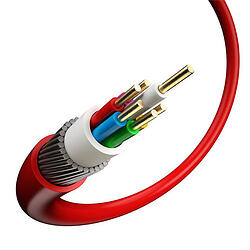As data center operators embrace 10G technologies and look to the future for 40G and beyond, a battle of technologies has begun. Established standards with probable upgrade paths are on the horizon, but emerging industrial scientific breakthroughs continue to ignite debates between upgrade paths. Two of the biggest face-off's seen in the telecom industry of late are: higher fiber count vs higher transmission cables and 10GBASE-T vs SFP+ cabling.

Fiber-Count vs Transmission Rates: Future-Proofing Or Overkill?
In 2008 a pair of standards ratified by the IEEE suggested upgrade paths for 10 Gig/lane multimode conductivities. Despite that over half a decade has passed, relatively few data centers are running 100 Gig today, and of those that have, singlemode is often used insted of multimode. As technology undoubtedly evolves, there will be a need to understand the difference between the 10, 40 and 100 Gigabit options.
The two standards in question - 40GBASE-SR4 and 100GBASE-SR10 - detail standards for a 40 Gbits/second and 100 Gbits/second system, but with 4 channels and 10 lanes respectively. Since each "lane" of data transmission requires a send and receive route, an SR4 option would mean using 8 fibers, and an SR10 option would be 20 fibers.
The debate between quality and quantity can be tricky, especially depending on a seemingly endless number of variables that can affect an upgrade path. The next generation of ethernet data transfer technologies will undoubtably follow the path of reduced fiber counts and improved transmission rates, however.
While the future is undoubtedly a migration to a system that can handle larger amounts of data, for some time there was uncertainty as to whether additional fiber counts couldn't be used instead of higher data transmission per lane. When you can run 100 Gig over just 8 fibers though, you’re back to using 12-fiber MPO solutions—precisely why the use of 24-fiber MPO solutions today. But it’s more than just what’s on the horizon for standards.
The functionality of larger quantity arrays of fiber MPO connectors leads to higher connector losses. While standards require a total connector loss of 1.0dB for both 40 and 100 Gigabit channels, Belden low-loss 12 fiber connectors can offer a 60% reduction from typical 24 fiber MPO connectors: that's going from .5 dB to .2 dB.
While at first glance a 24-giber MPO solution might seem like a simple point to point solution for your data center, in reality it can wind up being a much more costly option once you start diving into the details. And while a 12-fiber MPO solution today will easily support 10, 40 and eventually 100 Gig with better loss, more flexibility and industry-wide acceptance now, it is important to tailor your upgrade path to your data center and current solution.

10GBASE-T vs SFP+ Cabling: A Battle Of Technologies
Another important decision to make in the migration to higher data transmissions is between 10GBASE-T and FSP+ cabling. While there are many different ways that we could compare the two systems, there are four main categories that sum up the debate: Power, Latency, Interoperability & Cost.
Power
While power requirements for 10GBASE-T systems have managed to decrease to around 1.5-4 watts per port from their high of 12 watts per port, they are still much higher than the SFP+'s 1 watt per port requirements. In addition to a higher utility bill, higher watt usage also leads to more heat generated which can further impact your data center operation.
Latency
Simplified mechanics of SFP+ connectivity allows lower latency, typically about .3 microseconds compared to the 10GBASE-T which has about 2.6 microseconds of latency per link. In an environment of 3 switches, there could be significant delays of about 8 microseconds for 10GBASE-T connectivity.
Interoperability
As a standards based technology, 10GBASE-T has the advantage over SFP+ in terms of being interoperable. The familiar RJ45 jacks provide backwards compatibility with legacy networks thanks to autonegotiation (the feature of being able to autonegotiate between speeds ranging from 1 and 10 gigabit speeds).
Cost
An SFP+ solution can also be quite costly compared to 10GBASE-T. Since SFP+ systems are usually proprietary in nature, the material and equipment can be substantially more as shown below.

Holistic Data Center Design: So Where Does That Leave Me?
When faced with choosing between SFP+ and 10GBASE-T, quality and quantity, upgrade paths and entire solutions, carefully consider your needs. If power consumption and lower latency are critical, SFP+ might be the solution for you. If cost, flexibility and scalability are more important, you’ll likely want to consider 10GBASE-T.
Of course, this is an oversimplification as the obvious answer is also the most frustrating - every solution will depend upon your particular situation. Regardless of which solution you may decide on, it is always a good idea to keep in mind the bigger picture of your data center working as a whole and what the future will hold in store for moves adds and changes. This is why we suggest a holistic approach to designing and upgrading your data center.
For more information, get this white paper detailing 10 steps on how to approach your holistic data center design:
You can also simply contact your local Accu-Tech representative today!



.png?width=58&height=58&name=X_logo_2023_(white).png)
